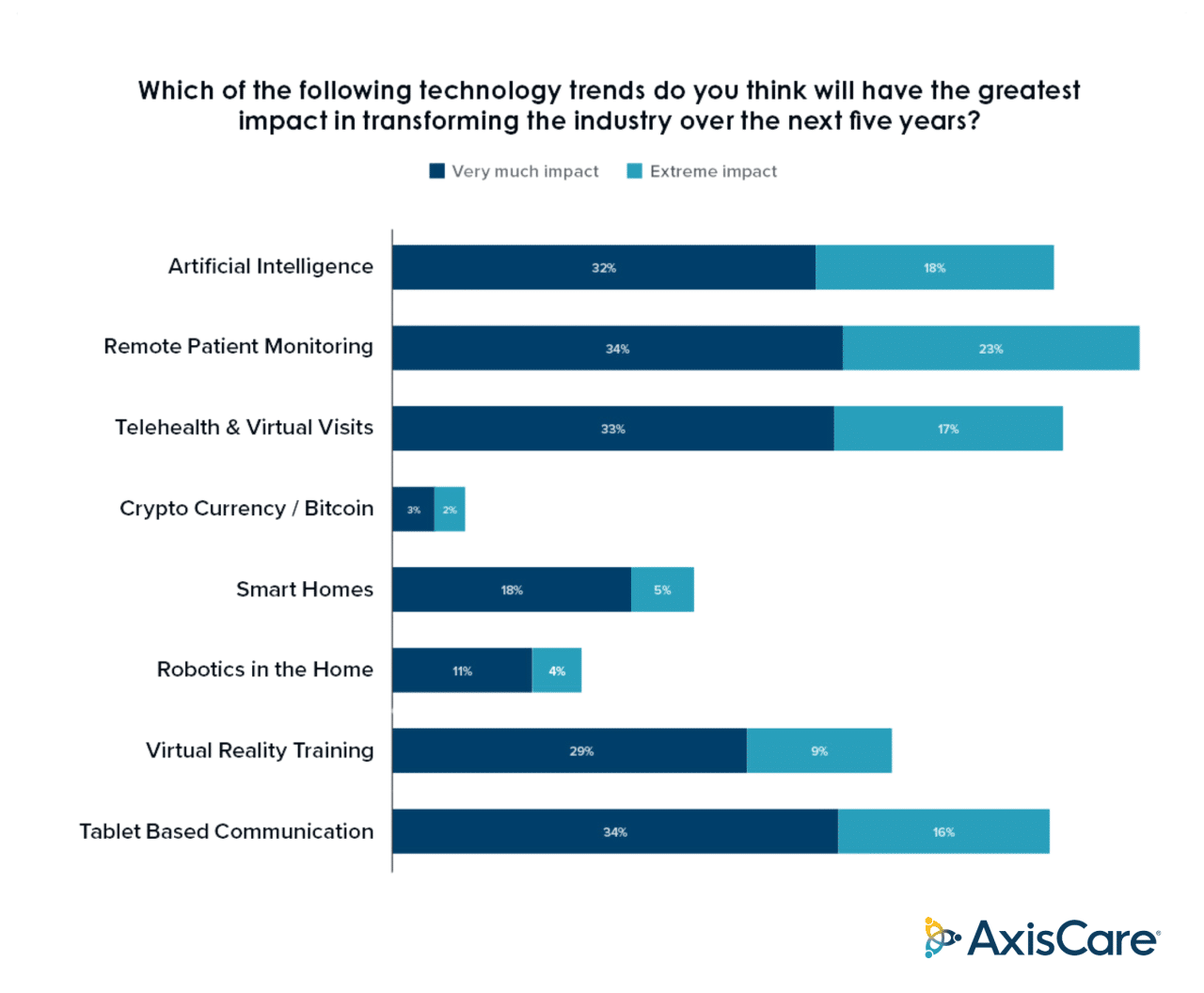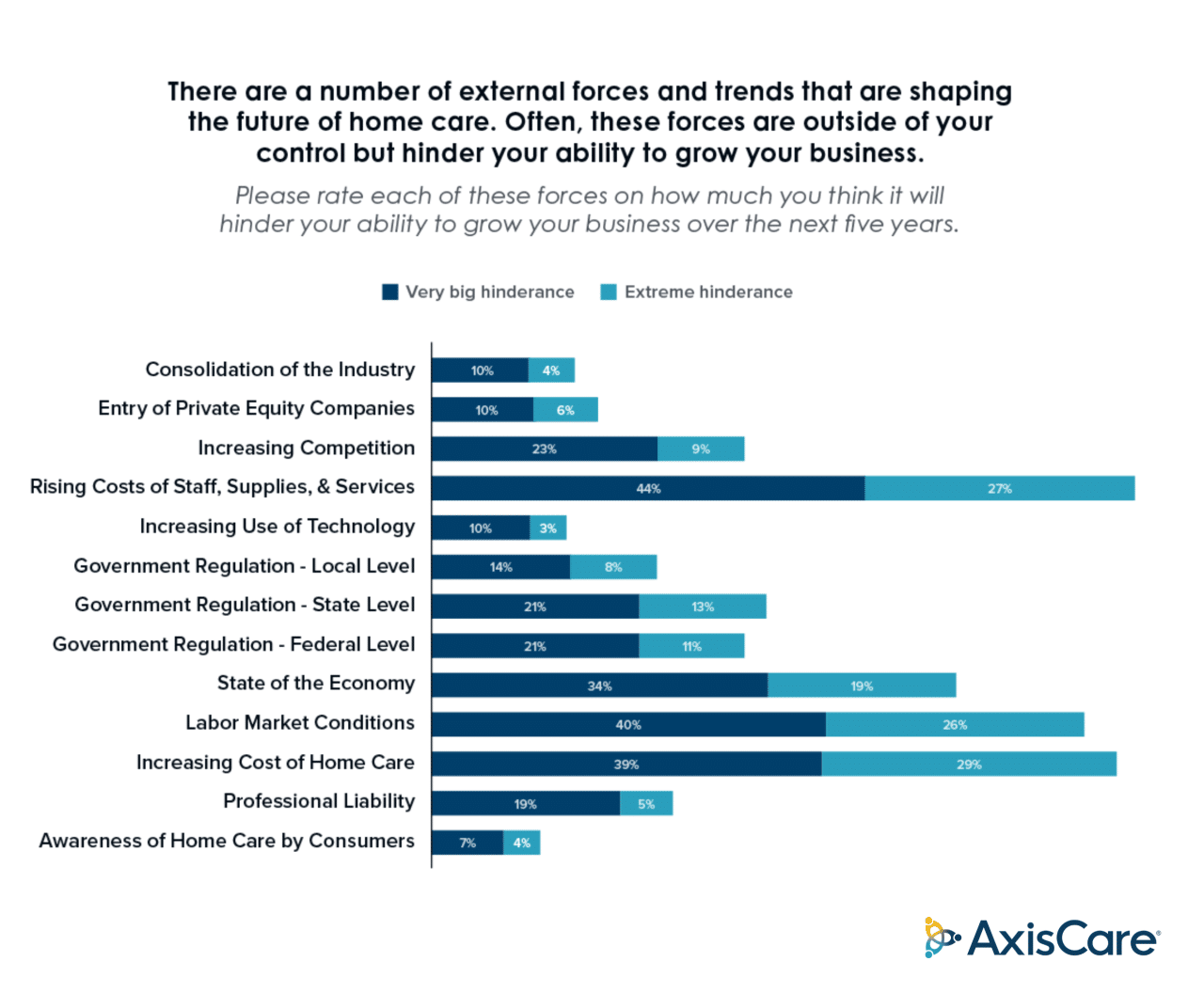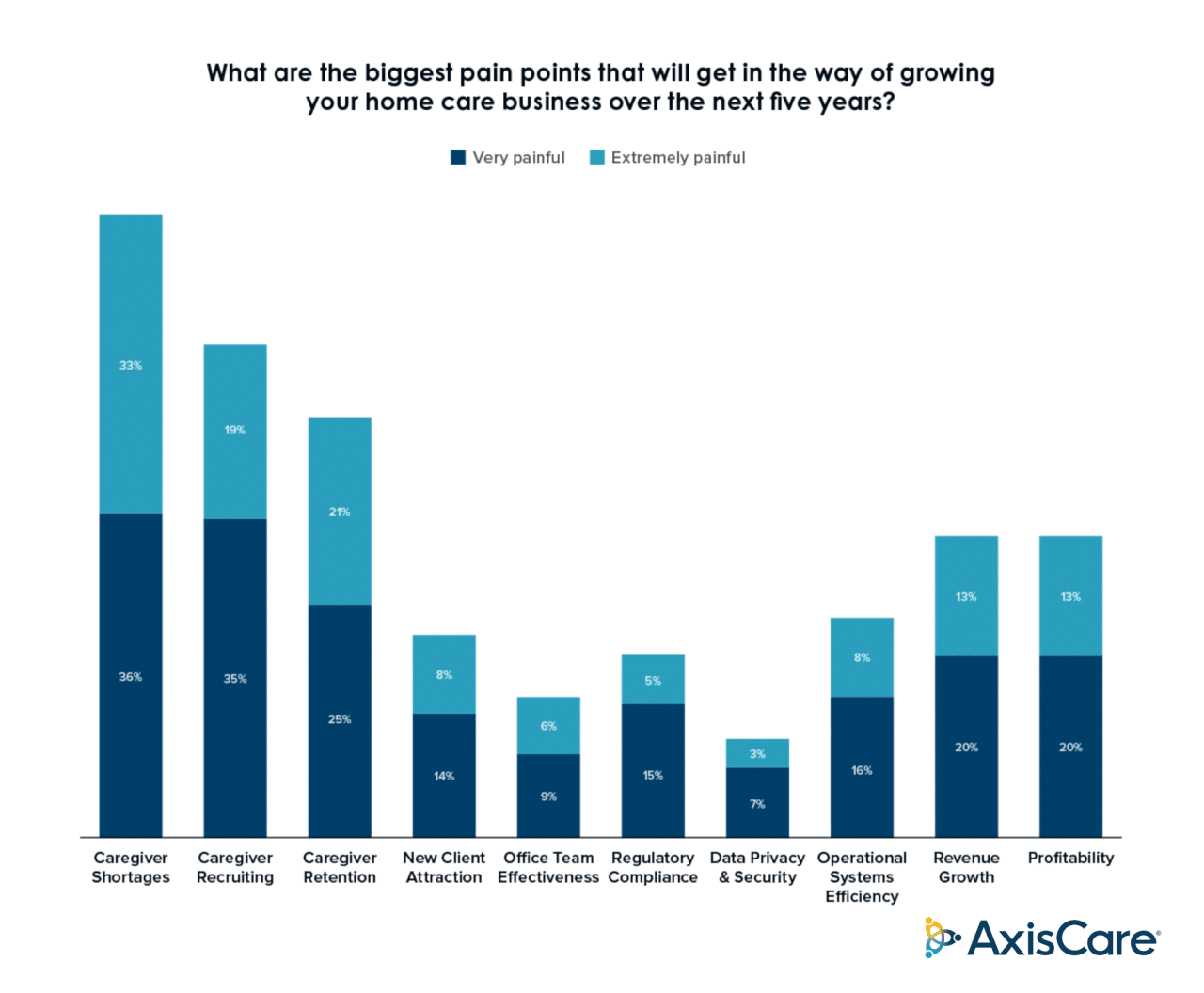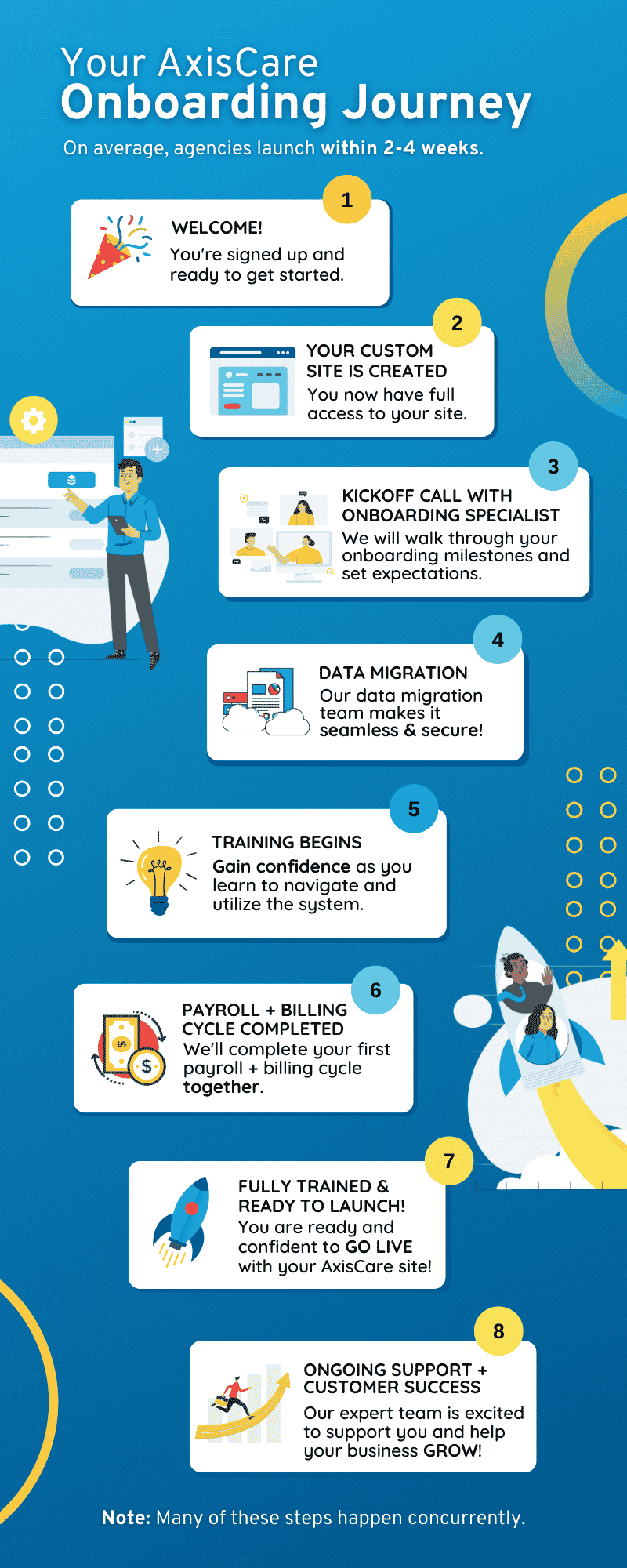Non-Medical In-Home Care Trends in 2024
Home health care is a bit of a misnomer. Many caregiver interactions involve medical interventions like managing medications and monitoring vitals – but there are plenty of other ways caregivers can provide non-medical care at home. From assistance with daily tasks to everyday companionship, non-medical care is a very broad offering. Here are the trends to watch for in the non-medical home care industry in 2024 and beyond.
Growing Demand for Non-Medical Care
The need for in-home care of all kinds is on the up, with no signs of slowing down. There are a number of factors driving this spike in demand, including:
Aging Population
According to the US Census Bureau, the number of Americans aged 65 and up is projected to increase from 58 million in 2022 to 82 million by 2050. That’s equivalent to a 47% jump.
Preference to Age In-Home
Most of us view home as a comforting and peaceful place. That doesn’t simply change as we age. Non-medical care gives individuals the support they need to age gracefully at home, preserving a sense of independence and autonomy.
Reduce Costs
A significant number of agencies generate most of their revenue from Medicaid and Medicaid Waiver programs. Non-medical care services usually fall under private pay, offering a range of affordable options for patients and their families.
The Role of Technology for In-Home Care
Like most industries, technology is playing an increasingly central role in supporting home care aides and agencies. New advancements in health tech, particularly artificial intelligence (AI), will completely transform how we administer care in the not-so-distant future.
The Use of AI for In-Home Care
A recent third-party survey commissioned by AxisCare highlights the emerging tech trend and its estimated impact on the home care industry in the next five years. AI ranked highly for impact, with 18% of respondents indicating an “Extreme” and 32% expressing it to have “Very much” of an impact.
In the home care space, there’s plenty of data analysis that happens behind the scenes. Providers are constantly trying to provide better, more tailored care, and the AI revolution is making it significantly easier to detect patterns and trends. These findings can be used for everything from preventive medicine to creating personalized home care plans based on dietary restrictions and preferences.
Remote Patient Monitoring (RPM)
Intelligent sensors can instantly alert caregivers or emergency services in case of a fall or injury. They can also monitor vital signs, medication adherence, and other metrics in real-time, keeping patients and practitioners more connected than ever. Survey respondents expect RPM to play a significant role in the near future, with 56% of respondents saying it will impact their operations “Very much” or “Extremely” within the next five years.
Streamline Patient Documentation
Hard-copy documents are nearly impossible to standardize and keep organized. Mobile-first patient documentation solutions put accurate patient data at everyone’s fingertips, making it easier to deliver continuous care and update essential information at the point of care.
The Role of Data Analysis
Beyond leveraging data to improve patient experiences, agencies will also rely on it to help them evaluate their efficiency across departments. Information, including caregiver job satisfaction, staff turnover, and training results, will all contribute to more streamlined operations, helping agencies pinpoint weak spots and be proactive in their resolution.
Rising Cost of In-Home Care
With demand on the rise and caregiver retention issues as present as ever, the cost of in-home care is increasing. And with the number of Americans ages 65 and older forecasted to increase by 47% from 2022 to 2050, this trend is something every agency will have to contend with.
Increasing Operational Costs
Demand for higher wages, high staff turnover rates, and a growing need for caregivers are all applying upward pressure on the cost of in-home care. Agencies are also spending more on new equipment and ongoing maintenance, coupled with the pressure to expand their service offerings to meet increased patient demand.
These escalating expenses pose significant barriers to growth and sustainability, and in turn, innovative strategies will be required to optimize resource allocation. A staggering response indicated 44% finding the increase of operational costs as a “Very big hinderance” and 27% “Extreme”.
State of the Economy
Caregiver shortages are at the crux of so many challenges facing agencies today, and they tie into economic conditions as well. The labor market is currently strained, and coupled with existing caregiver retention issues, it has created a perfect storm.
The cost of home care services in general, has also been exacerbated by inflation, and stringent government regulations require compliance with complex standards. This increases agencies’ administrative burdens and puts them at risk of being heavily fined in the event of a compliance oversight. 34% of AxisCare’s survey respondents found the the state of the economy as a “Very big hinderance” and 19% “Extreme” when looking to grow their businesses.
Wage Growth
While demand for caregiving services is on the rise, caregivers are still subject to relatively low wages compared to other career paths. Most practitioners make between $15 and $20 per hour, depending on their location.
Reimbursement Issues
Medical home health services often receive reimbursement through insurance or government programs. However, non-medical care is typically a private-pay service, meaning agencies must rely on individuals’ discretion to pay on time and in full, causing unpredictable cash flow.
Shortage of Caregivers
Recruitment, retention, and training have long represented points of concern within the industry, and they are only poised to become more prominent in decades to come.
Labor Shortage
Attracting and retaining caregivers is arguably the biggest challenge facing agencies today: AxisCare’s third-party survey states that , 54% of respondents said they’ve experienced significant difficulties with recruitment, and 46% said their retention challenges range from “Very Painful” to “Extremely Painful.” The larger the agency, the more acutely these pains were felt.
Download your copy of: The Future of Home Care: A 2024 Survey of the Home Care Industry & Future Trends to learn more.
Caregiver Recruitment
In that same survey, 55% of respondents said they want to focus on caregiver recruitment in the future. A lack of skilled caregivers in the labor market, stiff competition from other areas of the healthcare sector offering higher wages, and the demanding nature of caregiving work create a twofold challenge for agencies: turnover is high, and attracting employees in the first place is an uphill battle.
Caregiver Retention
No stage of the employee lifecycle is easy for agencies: another 46% of our survey respondents said they find their retention challenges to be either “Painful” or “Extremely Painful.” The same circumstances that make recruitment a difficult beast apply to caregiver retention, requiring agencies to remain engaged at all times and keep a finger on the pulse of employee satisfaction.
Caregiver Training
Given these retention issues, caregiver training is no easy task; in order to effectively absorb training materials, caregivers must feel engaged, committed, and motivated. Additionally, even if training is administered successfully, frequent turnover is equivalent to a “leak” in agencies’ knowledge buckets.
The Role of Technology & Caregivers
Implementing new technology can come with its share of friction, especially if caregivers belong to an older or less tech-savvy demographic. While apps, scheduling tools, and AI can all take work off caregivers’ plates, it may still take time to impart the value of these upgrades.
Growing Personalization in In-Home Care
Healthcare should never be a one-size-fits-all solution, but it often shakes out that way due to massive demand and very limited resources. In-home agencies are looking to increase their capacity for personalized care to improve outcomes, deliver better service, and boost satisfaction for all parties involved.
Improving Person-Centered Care with Software
Person-Centered Care is an emerging healthcare philosophy that increases patient involvement in the decision-making process, while making a greater effort to accommodate their preferences. To successfully implement PCC, agencies need to free up enough bandwidth to give each patient proper time and attention – and home care software is the answer.
By automating admin tasks and optimizing routine responsibilities like scheduling and billing, a home care platform can be the springboard for launching a PCC program.
Optimizing Communication Between Caregivers & Patients
Without open communication and deep understanding, personalized care simply cannot exist. Using technology to create a fluid channel between caregivers and clients – from providing feedback to involving family members – can quickly get to the bottom of patients’ needs and preserve a written record to reference whenever needed.
Adapting to the Changing Landscape
The only constant in life is change. Agencies must be equipped to respond to shifts in the market, whether they’re sudden or a slow burn. This ongoing process involves recognizing and responding to trends, emerging technologies, changing regulations, and the evolution of patient needs.
Emerging Technologies
AI, telehealth, and remote monitoring systems are constantly improving to boost efficiency and improve patient care. Agencies should remain realistic about the feasibility of integrating new technologies into their existing workflows, setting themselves up for a smooth adoption process and never biting off more than they can chew.
Business Models
There’s more than one way to retain clients in this industry. Models such as bundled care packages or diversifying your payer sources can broaden your potential customer base and create new revenue streams.
Regulations
Regulatory requirements can change at the drop of a hat. Whether it’s at the local, state, or federal level, agencies must keep a close watch to mitigate legal risks and remain compliant. Proactively engaging with regulatory bodies and participating in industry associations is a great way to make sure you’re the first to know about these changes.
Population Preferences
As demographic shifts occur, care preferences often follow suit. Increased demand for at-home service and technological intervention is just one recent example; agencies have a responsibility to keep an ear to the ground if they want to remain relevant in an increasingly diverse and dynamic healthcare market.
Future-Proof Your Non-Medical In-Home Care With AxisCare
With AxisCare, your agency will be ready for and equipped for industry-wide changes and challenges. Our ever-evolving platform, coupled with our responsive customer service, is the key to maintaining your competitive edge and being at the forefront of non-medical care. Curious? Book a demo.
For more data and insights, download your free copy of The Future of Home Care: A 2024 Survey of the Home Care Industry and Future Trends












